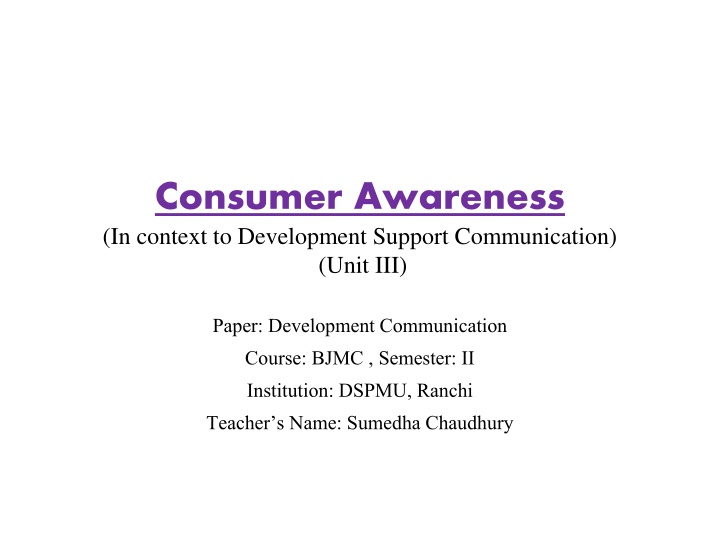
Consumer Awareness in Development Communication
Explore the concept of consumer awareness in the context of development support communication, discussing consumerism, changes in consumer behavior, and the impact on rural and urban populations in India.
Download Presentation

Please find below an Image/Link to download the presentation.
The content on the website is provided AS IS for your information and personal use only. It may not be sold, licensed, or shared on other websites without obtaining consent from the author. If you encounter any issues during the download, it is possible that the publisher has removed the file from their server.
You are allowed to download the files provided on this website for personal or commercial use, subject to the condition that they are used lawfully. All files are the property of their respective owners.
The content on the website is provided AS IS for your information and personal use only. It may not be sold, licensed, or shared on other websites without obtaining consent from the author.
E N D
Presentation Transcript
Consumer Awareness (In context to Development Support Communication) (Unit III) Paper: Development Communication Course: BJMC , Semester: II Institution: DSPMU, Ranchi Teacher s Name: Sumedha Chaudhury
What is Consumer Awareness? What is Consumer Awareness? Consumerism or Consumer Awareness can be defined in many ways and viewed in different perspective. It is a social and economic order and ideology that encourages the acquisition of goods and services in ever-greater amounts. This speaks about the active buying and selling by the consumer.
Development on Consumer Awareness Development on Consumer Awareness The development in the consumer oriented tendencies, marked by the availability of a variety of manufactured consumer goods and active advertising of the products in various media. A large part of consumerism depends on advertising. A second aspect of consumerism discourse relates to the everyday patterns of behavior one expects to find in consumerism or commercialism. This also means that a large percentage of Indian population lives in rural sector as opposed to urban centers. Currently, the division between rural and urban population distribution is 70% to 30%.
While this reveals a large rural bias, it however points to a dramatic shift to greater urbanism because in 1960 the distribution was 85% and 15%. Urban industry, which was barely existent thirty years ago, generates 40% of the national output. The rural labour force still exists based on historically constructed competing groups, the structure of the urban labour force is becoming more cosmopolitan. caste lines as non-
The Changing Scenario The Changing Scenario Consumer Awareness essentially means the growing wants and needs of an individual for goods and services. India is one of the largest and fastest growing economies in the world. The consumer s standard of life is going higher and hence his or her needs are increasing. Consumerism in India, is in a new high, and refuses to show signs of budgeting consumer, due to his exposure, of the global market, strives to get the best of the goods in his home land. Consumer tastes and changing. anymore. The Indian preferences are definitely
